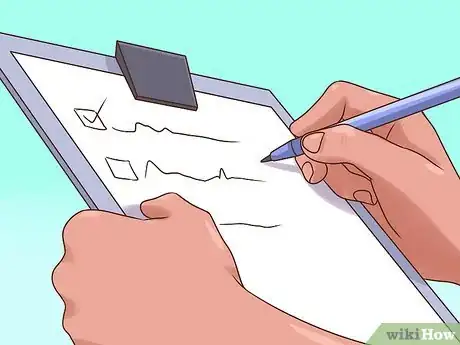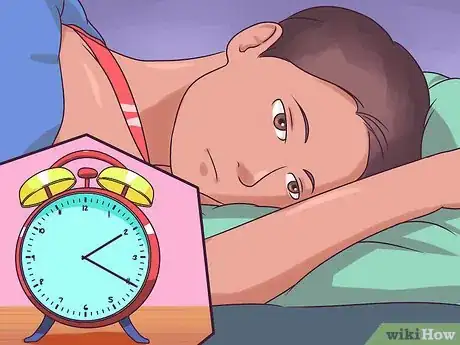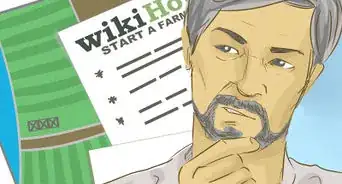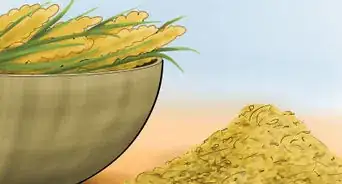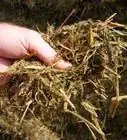This article was co-authored by wikiHow Staff. Our trained team of editors and researchers validate articles for accuracy and comprehensiveness. wikiHow's Content Management Team carefully monitors the work from our editorial staff to ensure that each article is backed by trusted research and meets our high quality standards.
There are 7 references cited in this article, which can be found at the bottom of the page.
wikiHow marks an article as reader-approved once it receives enough positive feedback. In this case, 95% of readers who voted found the article helpful, earning it our reader-approved status.
This article has been viewed 311,119 times.
Learn more...
Farmers markets, once the typical way of selling produce for centuries, have again grown to become an important part of local community food shopping. They're the place to find fresh local produce, catch up with people from the community, share great food and take home seasonal treats that the supermarkets aren't necessarily going to be selling. And if you want to become part of a local farmers market, and sell your own homegrown or home produced food or household necessities, then you'll need to do some planning to ensure that your efforts are as effective, as they are lucrative.
Steps
-
1Make a checklist of everything that you will need, in order to be prepared.[1] This makes it easier to ensure that everything has been made or picked, and packed up to prevent last-minute panic. Being part of a farmers market means hard work. You will need to prepare produce leading up to the day, transport it safely and set up very early in the morning before customers arrive. You may also need to carry your own stand or display, depending on what the local market provides. During the day, you will need to be present and charming throughout the day, and even your lunch break may be a rushed sandwich while sitting behind the produce you're selling. All the same, this hard work is worth it––you get better returns for your retailing the food produce than participating in the food auction and wholesaling to a supermarket chain. And the social interaction is fun, lively and real.[2]
- It's a good idea to make friends quickly at the market, as these people will cover for you when you need a bathroom break or need to dash off to get change. In turn, they'll expect the same cover from you.
- Are you planning on doing this alone or with a friend or partner? It's easier when at least two of you share the effort.
-
2Decide what you're going to sell. Farmers markets tend to sell fresh grown produce (all sorts of vegetables and fruit, nuts and seeds, etc.), freshly killed meat products, fresh fish, home or artisan baked goods, drinks (hot or cold) and homemade foods such as jams and jellies, pâtés - pahtaes (meat spreads), terrines - tuhreens (chopped and cooked meats, fish or vegetables to serve cold), jerky, pickles, sauces, condiments, etc. Some things to bear in mind include:[3]
- Advertise that you grow food in a special way to increase its appeal and value to customers. Such as, are you an organic or conventional grower?
- Arrange for the appropriate transportation for getting your food to market. It's no good growing a lovely crop of peas and pumpkins and not being able to get them to market for want of a van, trailer or large car. If you don't have appropriate transportation, is there someone else who'd be able and happy to help?
-
Sell specialty cottage industry products only -- if those could sell well -- such as homemade soaps, beauty products, leather or wood products, herbs, sewn or knitted goods, clothing, etc. -- or spare a part of your stall for them while still selling food items.
Beware of farmers markets that are very purist about what is sold and so prefer only fresh food; it all depends on where you live and what people consider makes a farmers market.
Advertisement -
3Get certified by the Board of Health in your county or area.[4] If you're a food vendor (which most people are), you will likely need to get certified, if you serve foods. Know what rules exist in relation to growing, producing, serving and/or selling foods. Many jurisdictions have strict laws against selling food items from home kitchens, although in recognition of the increasing desire of people to sell and buy homemade food products, some of these restrictions are starting to be relaxed again. If you need to use a commercial kitchen space, can you organize a cooperative to share with another person or group of people also selling at the market?
- Know how to avoid potential hazards when making homemade food by using correct procedures, such as sterilizing bottles and using high heat, etc. If you're not sure, read up on the food type before deciding that you'll include it as part of your stall––no point having jams and salsa--if you can't be bothered going through the hassle of sterilizing and sealing properly.
- If you're certified by a health board or similar agency, expect officials to come for inspections when the market is on. Keep everything neat, tidy and clean, using proper head-coverings, rubber/plastic gloves. If you have any violations, then you may be asked to leave, at least for that one market, until everything gets sorted out.
-
4Get in touch with the owner, master or organizer of the market. This person (or perhaps even a committee) will tell you what the rules are for becoming a part of the market. In some cases, it will be quite formal, and you'll need to submit to an interview to convince the other owners and operators that you are a worthy participant, likely to sell quality produce. Find out whether there is a cooperative you can join––cooperatives provide power in numbers that also helps to cover marketing and sales and distribution even beyond the market.
- Have a sales pitch already prepared in advance. You're going to fare better, if you present as confident and already decided on what it is you want to contribute to the market.
- Check out the potential competition before you go. Although most farmers markets have a cooperative spirit, there is no point in being the fifteenth stall selling berries as there won't be enough customers to go around. Think of ways to add value to your produce--if this is an issue, such as turning those berries into berry milkshakes. Or perhaps turn your stall into a cooking class, showing people 101 ways to do things with the berries they've bought from you or others, all for a small fee.
- Expect the market to provide you with some information too. Ask how many customers there are, what seasonal fluctuations exist, whether there are costs to maintaining a stall (such as having to pay, even if you don't turn up one time) and what insurance is provided to cover public liability.
- Is the market under cover or outdoors? Some markets have a system of being outdoors when the weather is fine but moving under cover, if it is inclement. A lack of cover may affect your decision to participate.
-
5Prepare your stand or market stall.[5] Once you're accepted as part of the farmers market, plan how you will set out your wares. Will you have a table with chairs, a stand, a tent or just your product sitting on something simple like a trailer or bales of hay? Depending on what you decide will be your display method, you will need to obtain or purchase the items. You may need; folding chairs, trestle table, display tent, canopy or large umbrella, stands, tablecloths, money holder and a calculator. In some cases you might be in a position to accept credit card transactions so consider equipment such as a portable point of sale machine or even a cell phones. Remember that cash is often king at the farmers market, and many provide ATMs for cash withdrawals, so you might not want to go to this added expense.
- Whatever you choose to keep your money in, make sure it is secure and always in your sight. Many vendors choose to carry cash in a bum bag worn around the waist. If you're innovative, you can even divide the bum bag up into coins and notes and spare change.
-
6Prepare the day before the market.[6] You won't have time to pack or pick on the day of the market––usually it'll be all you can do to tumble out of bed and get there nice and early. The best approach is to prepare all the produce and pack the car or van by the night before, ready for an early leave. The exception to this may be, if you're happy to go to be very early the night before--and get up extremely early to bake or make food just before leaving.
- In many cases, it's easiest to bake the day before, and if the food can handle it, even earlier than that. Try freezing some products and thawing them the night before.
- Package goods that require it.
- Pick produce the day before and have it loaded into boxes or other containers ready to go. Keep in a cool place ready for quick loading just before you leave.
- If the market requires that you list the ingredients of prepared food, make tags or labels in the days before. It's a good idea to do this whether or not the market requires it, as customers like to know what's in their food. If you make labels on the computer, save them to a folder for future use––this will speed things up when you make the same product again.
- Hook the trailer up to your vehicle in readiness. If you would need to back out with a trailer, try to reverse it (turn it 180 degrees) and back it into your drive during the daylight, when it's easier to see. Or, leave it on the street in front of your house, if that's safe.
- Organize the change. You'll need plenty of change, so head to the bank, if you haven't enough already.
-
7Get to bed early![7] Farmers markets are usually on a Saturday or Sunday so, even though it's a Friday or Saturday night, try to get to bed around 9:00 P.M. You're going to need all of the energy you can get by the time morning comes.
-
8Wake up early the morning of the market.[8] Go extra early, if it's your first time; so that you can get everything set up. As you become more experienced, you'll learn shortcuts that buy you a bit more time in bed but for the beginner, it's best to start early so that you can fix anything that might not go right the first time.
-
9Engage your customers.[9] Always say a friendly "Hi" or "Good morning!" to people who walk in front of your booth. Be ready to discuss your produce in details, its origins, your passion for it and how fresh it is. The purpose of a farmers market is the ability to cut out the middleman and engage directly with customers so that they can grasp the love and care that has gone into producing the products you're offering. Be prepared to spend time chatting––it's part and parcel of being involved in a farmers market.
- Smile, even if there are no cameras around. Customers like to come into a booth that has friendly people staffing it.
- Be proud of what you're doing. You are part of the restoration of local foods being produced and sold directly to consumers without all the ineffectiveness and distancing the larger food sales chain has brought into play. You are helping to build community, create a livelihood for yourself and maybe for others, and you are helping people eat the healthy food that they deserve.
Community Q&A
-
QuestionWhat are the fees for becoming a farmers market vendor?
 Community AnswerThere is usually no fee beyond the rent you pay for the booth, generally about $20 monthly for a 10x10 booth.
Community AnswerThere is usually no fee beyond the rent you pay for the booth, generally about $20 monthly for a 10x10 booth. -
QuestionWhat permits do I need to be a farmer's market vendor?
 Community AnswerUsually, you'll need a business license through the city, and a county health department permit.
Community AnswerUsually, you'll need a business license through the city, and a county health department permit. -
QuestionCan I sell fresh salsa at a farmers market?
 Community AnswerTalk to the organizer of your specific farmers market to learn its regulations.
Community AnswerTalk to the organizer of your specific farmers market to learn its regulations.
Warnings
- Be prepared for rain, thunderstorms, wind and blistering hot sun. Bring an electric fan, if it will work where you're stationed.⧼thumbs_response⧽
- Bring stakes to tie and weights to weigh your canopy down––sometimes the wind is so strong that it could blow your canopy away!⧼thumbs_response⧽
- Be enthusiastic, smile. Don't slouch or cross your arms as if you are not very interested in meeting new customers. Sometimes, there are people taking pictures of the market, and you don't want to get caught looking bored! Watch your body language in general––you don't want to give off signals that you aren't interested in having customers call at your booth, or seem as if you are ignoring them.⧼thumbs_response⧽
- Being a vendor is a lot of work. You have to put your all into it, and you'll probably get worn out quickly. But in time, you grow stamina and learn ways to cope so that it will soon seem a lot easier.⧼thumbs_response⧽
- You'll need to be ready the previous evening, to set up your spot early. This could mean 5 or 6 in the morning!⧼thumbs_response⧽
Things You'll Need
- Tent, canopy, large umbrella
- Display table, trestle table, folding table, stacked boxes
- Produce
- Signs and labels
- Licenses or certification (where relevant)
- Transportation vehicles, trailer
- Change and a bum-pack to carry your money on your body
- Calculator, possibly attached to the counter
- Carry bags (optional)
References
- ↑ https://extension.unh.edu/resources/files/Resource004139_Rep5905.pdf
- ↑ https://www.forbes.com/sites/moneybuilder/2012/04/11/how-to-make-money-at-the-farmers-market/
- ↑ https://www.moneycrashers.com/sell-farmers-market-business-vendor/
- ↑ https://www.moneycrashers.com/sell-farmers-market-business-vendor/
- ↑ https://www.mass.gov/guides/a-guide-to-selling-at-farmers-markets#-equipment-
- ↑ https://extension.unh.edu/resources/files/Resource004139_Rep5905.pdf
- ↑ https://www.sleep.org/articles/train-go-sleep-earlier/
- ↑ https://www.entrepreneur.com/article/300788
- ↑ https://www.mass.gov/guides/how-to-run-a-farmers-market#-how-to-sell-at-a-farmers'-market-
